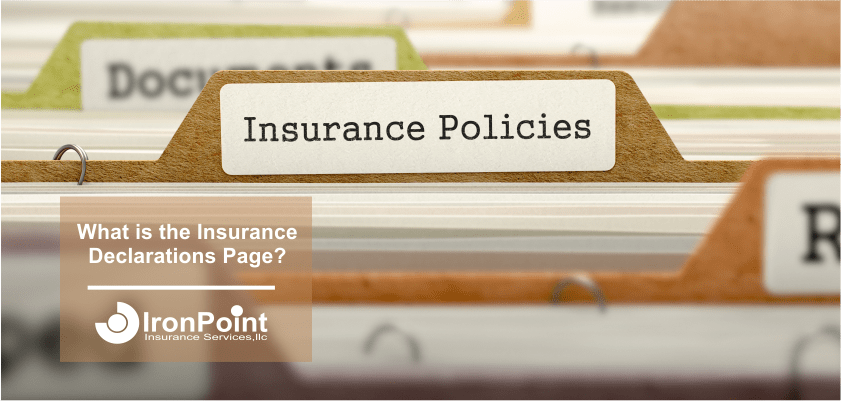What Is an Insurance Declarations Page? (And Why You Should Read It)

Most people file their insurance declarations page away without reading it. Not because they’re lazy – but because they don’t realize they’re overlooking the single most important document in their policy document package.
Let’s be real – if you only read one page of your entire policy, make it the declarations page. Think of it as the control panel of your insurance policy. It’s where all the important switches, settings, and measurements live.
Skip this page, and you might as well be driving a car while ignoring the dashboard. You’ll cruise along fine until the moment you realize you’ve been running on empty for the last 20 miles.
This insurance declarations page isn’t just some obligatory paperwork generated to satisfy regulatory requirements. It’s the only place where your coverage, costs, and exclusions are laid bare without the comforting blanket of insurance-speak.
The Declarations Page: Where Insurance Companies Cut to the Chase
The declarations page sits at the front of your policy for a reason. No one tells you this, but it’s the only page insurance companies can’t hide behind industry jargon and legal footnotes.
While most people see it as just another form – insurance professionals know it’s the document that translates insurance-speak into actual English. It’s where vague promises like “comprehensive coverage” and “peace of mind” get specific numbers, names, and limits attached to them.
When you read insurance marketing materials, you get promises. When you read your declarations page, you get facts:
The Auto Insurance Declartions:
- Policy Details: When coverage starts and ends. Pay attention to that end date – it’s remarkable how many people discover they’ve been driving uninsured only after they’ve met a telephone pole up close and personal.
- Driver Information: Everyone who’s covered, and more importantly, who isn’t. That “good friend” who “just needs to borrow the car for an hour”? Check here first, or you might be funding their mistake for the next decade of premium increases.
- Vehicle Information: Your cars, identified by VIN numbers apparently designed by cryptographers moonlighting in the automotive industry.
- Coverage Breakdown: The heart of the matter – what protection you actually purchased versus what you assumed was included. This section has shattered more expectations than a dating app profile picture from 2010.
- Liability Limits: Those cryptic fractions like “$100,000/$300,000” that seemed adequate until you realize the average hospital visit costs more than your kid’s out-of-state tuition, and with none of the dorm parties to show for it.
- Deductibles: The financial hurdle you’ll clear before insurance kicks in. Choose a $1,000 deductible to save $50 in premium, and the universe will immediately ensure your next claim is exactly $1,001.
- Premium Costs: Where theory meets practice – what each piece of the coverage puzzle actually costs you. Often featuring numbers conveniently rounded down during sales conversations, then mysteriously precise to the penny on your bill.
The Homeowners Insurance Declarations:
- Property Identification: Your home’s address and sometimes a brief description of the property type. Seem obvious? Perhaps, but verify it’s correct – I’ve seen claims denied over address typos that would make even a small-town postal worker roll their eyes.
- Dwelling Coverage (Coverage A): The maximum amount your policy will pay to rebuild your house. Here’s what no one tells you – this isn’t your home’s market value or your mortgage amount. It’s the estimated reconstruction cost, which in today’s market, changes faster than fashion trends.
- Other Structures (Coverage B): Protection for structures not attached to your home – detached garages, sheds, fences. Usually 10% of your dwelling coverage, which seemed plenty until you installed that backyard “she-shed” that costs more than your first car.
- Personal Property (Coverage C): Coverage for your belongings, usually calculated as a percentage of dwelling coverage. The dirty secret: categories like jewelry, electronics, and art often have specific sub-limits that wouldn’t cover half of what you spent on your engagement ring or gaming setup.
- Loss of Use (Coverage D): The amount available if you can’t live in your home after a covered loss. This pays for temporary housing and additional living expenses – the coverage everyone ignores until they’re trying to find a hotel that accepts three kids, a dog, and a monthly stay.
- Personal Liability: Protection if someone is injured on your property or if you damage others’ property. The standard $300,000 limit might seem impressive until your neighbor’s kid breaks an arm on your trampoline and their lawyer has a boat payment due.
- Medical Payments: Smaller coverage for minor injuries to others on your property, regardless of fault. Think of it as the “keep small problems small” fund – because sometimes a $5,000 medical payment prevents a $100,000 lawsuit.
- Special Limits and Endorsements: The customizations that make your policy unique. Water backup coverage, scheduled items, home business endorsements – the add-ons that determine whether your flooded basement is a covered claim or an expensive swimming pool installation.
Why Most People Miss What Matters Most
Here’s a truth the insurance industry doesn’t advertise: most insurance problems don’t stem from complicated policy language – they come from misunderstandings about basic coverage limits and exclusions clearly listed on the declarations page.
People skip reading this crucial document not because they can’t understand it, but because they assume it’s just a receipt – another piece of administrative paperwork.
It’s not.
Let’s be real – the declarations page isn’t fine print. It’s the opposite. It’s where insurance companies lay out in clear terms exactly what protection you’ve purchased. Skip it, and you’re essentially navigating your financial protection blindfolded, hoping you won’t crash into anything expensive.
Consider it this way: if your insurance policy is a house, the declarations page is the blueprint. You can admire the house all you want, but without understanding the blueprint, you’ll never know if that wall you’re planning to remove is load-bearing until the ceiling comes down on your head.
Questions Worth Asking About Your Declarations Page
“Is my declarations page the same as my insurance card?”
No, and confusing them could cost you thousands. Your insurance card is the minimum proof required by law enforcement – a permission slip that lets you drive legally. Your declarations page is the comprehensive snapshot of your actual protection and its limits. One keeps you legal; the other keeps you financially whole.
“If I’ve had the same coverage for years, do I need to review my new declarations page?”
Yes, because “same coverage” in insurance is like “same recipe” at your favorite restaurant after the chef changes – theoretically identical, practically different. Coverage details change, sometimes subtly. Inflation adjustments modify your protection. New discounts appear or disappear. Premiums shift. The declarations page tracks these changes when they happen – not when you discover them while standing in your flooded basement.
Making Your Declarations Page Work Harder For You
No one tells you this, but most people use their insurance declarations page reactively – if at all. Here’s how to use it proactively:
- Read it like there’s money at stake – because there is: Not carefully enough, and that new bookshelf might collapse under the weight of your hardcovers. Similarly, your declarations page deserves careful review when it arrives. Errors or misunderstandings spotted early prevent financial disasters later.
- Compare versions like you’re checking your ex’s social media: When a new declarations page arrives, compare it side-by-side with the previous one. Insurance companies make adjustments at renewal – sometimes in your favor, sometimes not. Changes to your policy aren’t announced with fanfare and confetti; they’re quietly noted on your declarations page, hoping you won’t notice.
- Use it as your shopping standard – because insurance quotes are like dating profiles: When other insurance companies offer quotes, have your declarations page handy. It ensures you’re comparing equivalent coverage, not just bottom-line prices. A $200 savings means nothing if you’re sacrificing $100,000 in essential protection. Don’t be the person who switches for a discount only to discover they’ve also received a coverage downgrade.
- Keep it somewhere findable – unlike your vaccination card: File it where you can access it quickly – digitally or physically. The middle of a claim situation is the worst possible time to go hunting for your coverage details, right behind searching for your passport two hours before an international flight.
How to Find Your Declarations Page
If you’re realizing you can’t remember seeing this crucial document, don’t worry. When you purchased insurance, it was definitely provided – it’s typically the first few pages of your policy documents.
Can’t locate it? Here’s how to get your hands on it:
- Log into your online account (where all your policy documents should be stored)
- Search your email for “policy documents” or “declarations page”
- Call your agent or insurance company
- Check your insurance company’s mobile app
Taking five minutes to locate this document now could save you significant stress when you eventually need to understand your coverage limits or file a claim.
The Bottom Line: Five Minutes of Reading That Could Save You Thousands
Your declarations page isn’t beach reading, but neither is the warning label on medication. Both are boring. Both can save you from disaster.
Think of it as the CliffsNotes for your insurance policy. The TV commercial promised you peace of mind. Your declarations page tells you what you actually bought.
The next time that insurance renewal arrives, don’t file it away unread. Five minutes with your declarations page today beats finding out what’s not covered when you’re already filing a claim.
After all, insurance regrets are expensive. And they’re entirely avoidable.
Let’s Get Started
Select the way you want to start your quote.
Let’s Get In Touch
Compare Quote Online
Let’s Get Started

Want to know if you can save on home or auto insurance? See for yourself. Start a quote today.
Call today and speak with a professional insurance agent.
1-877-334-7646






